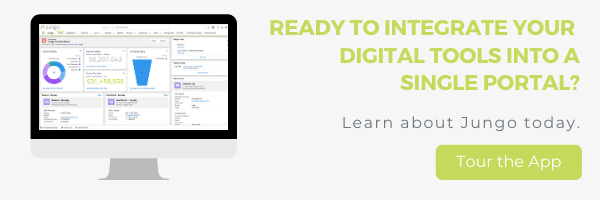
So, you’re using a stellar mortgage LOS (Loan Origination Software) that helps you manage your pipeline during the loan process. But, if your mortgage LOS and CRM (Customer Relationship Management system) are not integrated, you’re losing money and time.

First, let’s define some important terms.
What is a Mortgage LOS?
Loan Origination Software (LOS) is a platform for mortgage originators to manage the different steps of the loan servicing cycle. For example, loan officers can store data, process loan applications, gain credit approval, and automate underwriting through a LOS.
What is a Software Integration?
A software integration is a connection between two of your systems. Basically, it’s a way to make your tools “talk” to each other. There are different types of integrations, but the goal of all of them is to make your life easier.
Integrating your software helps you truly get your money’s worth by freeing you up to accomplish more everyday.
Why Do You Need Your Mortgage LOS and CRM Integrated?
Integrating your LOS and CRM is key to skyrocketing your success because these are two of the most powerful tools that you have at your disposal.
An integration between your LOS and CRM means that when loan data is updated in either platform, it syncs automatically to the other software. For example, if a borrower submits their loan application through your LOS, your CRM will update to reflect this new information.
Here are 10 ways that your life will be better through integrating your software stack and automating your processes:
1. Free Up Your Team By Ditching Double Data Entry
As we mentioned, one of the major benefits of integrating your LOS and CRM, is being able to ditch double entry. When a borrower’s information is updated in your LOS, that data is pushed automatically to your CRM. This means that your contact information is always up to date. Plus, your team doesn’t have to waste time transferring data between software platforms. This frees them up to work on high value tasks that actually earn you money!
Additionally, integrations minimize the human error that is just a part of data entry. By removing a step in your loan process, your team will make less mistakes and waste less time.
2. Distribute Fresh Leads and Convert Faster
How quickly you follow-up with new leads is a direct indicator of how many customers you’re able to convert. With great software integrations, a lead’s information can be automatically dropped into your CRM, so that an opportunity never slips through the cracks again.
And, with a fully integrated CRM, you can distribute leads to your team members right away. This will allow them to reach out quicker to win more business. Plus, you’ll save time by no longer needing to manually distribute fresh leads.

3. Leverage Hands-Off Drip Marketing
With LOS data syncing to your CRM, you’ll be able to leverage truly hands-off drip marketing. For example, if you indicate in your LOS that a borrower has submitted their application, that data will automatically sync to their contact page in your CRM. Then, through automated workflows, your customer is placed on a drip marketing email campaign that walks them through the loan application process step-by-step.
All of this is completed automatically, as soon as you move your customer to the next stage of the loan process in your LOS. Now multiply that time saving by every marketing campaign email you send out, to every one of your customers.

4. Loan Updates Send Automatically
Sending loan status updates to your clients and partners during the mortgage process is key to building trust. However, calling or emailing every single borrower, at every step of the loan process isn’t just time consuming, it’s inefficient.
Let your software take care of notifying your borrowers about changes in the status of their loan. Automated mortgage status updates can be sent via email or even SMS, so that your clients and partners are in the loop at all times.

5. Pipeline Notifications for Referral Partners
You might be in the habit of sending your referral partners weekly emails updating them on the status of all the loans in your pipeline they’ve referred to you. With the data pulled in from your LOS, you can create automated pipeline reports to send to your partners.
They will appreciate seeing how their customers’ mortgages are progressing with real-time data. And, you will love not having to manually gather and send the status of all of those loans.
6. Automate Post-Closing Emails, Gifts, and Follow-Up Reminders
What do you do as soon as a borrower’s loan closes? If you don’t have a clear answer, you’re wasting time on inefficient post-closing marketing strategies. With an integrated mortgage LOS and CRM, you’ll be able to automate your entire post-closing marketing plan.
Here’s what you can automate:
As soon as a borrower’s loan closes, your CRM will place them on a Keeping In Touch drip marketing campaign. They will receive a monthly email from you for two years after they close. Then, you can also choose to send them customized and branded gifts and cards to be delivered automatically on special occasions and birthdays.
Finally, your CRM will also remind you in three months to call your client and see if they have any questions about their loan. Then again a year after closing, you’ll be reminded to give them a call and wish them a happy loan anniversary.
All of these post-closing steps will help you earn more repeat business and referrals from your closed customers. And since your whole process is automated, you won’t waste any time.
7. Easily Run Annual Loan Reviews
If you keep your loan data outside of your CRM, you will have to set tasks for yourself to follow up with clients in a year’s time.
However, when your loan data is stored in your CRM, you won’t have to remember to call them. Your CRM will remind you.

And because all that loan data is in your CRM, it’ll be easy to update your clients on their options. Whether you use Mortgage Coach or another Total Cost Analysis tool, you can easily run annual loan reviews for your borrowers with data from your CRM, so that when you call them to wish them a happy loan anniversary, you have up-to-date data about their loan.
8. Market to Refinance Eligible Clients with Real, Dynamic Data
With mortgage rates as low as they are, more homeowners than ever are eligible to save money on their mortgage payments with a refinance. The data that is stored in your LOS can help you create dynamically informed marketing campaigns.
When your data syncs over to your CRM, you can run reports on which of your borrowers would be the most ReFi eligible. You can then market directly to them. Provide informative and targeted marketing to the exact audience who could most benefit. This is a foolproof way to build trust and earn business.
9. Access Everything On-The-Go
How many times have you been away from your desk, at an event, or a partner’s open house, and you receive a call about a client’s file? Now, you can instantly answer clients’ questions from anywhere. And you’ll have the assurance that their loan information is completely up-to-date and accurate. A fully integrated mortgage LOS and CRM with an award-winning mobile app will let you get more done, even when you’re not in the office.
Jungo’s LOS Sync
Jungo’s Mortgage CRM features a complete sync with the most popular mortgage LOS platforms, including Ellie Mae’s Encompass, Calyx Point, and Byte. This complete LOS integration will save you time and effort–not to mention the headaches and frustrations of double data entry.
But best of all, having your Jungo account and your LOS fully integrated means that you can actually use the data you’ve worked so hard to gather. Your data won’t be in a silo, it’ll be in informative reports and dashboards, and ready for you to leverage in the form of automated workflows, marketing, and streamlined team processes.
Bottom Line
Integrating your mortgage LOS and your CRM is one of the most effective ways for you to invest in your business. Making your data work for you will power your client communication. Plus, you’ll have more time and energy to tackle your to-do list. Your software will be handling all of the automated backend processes.







